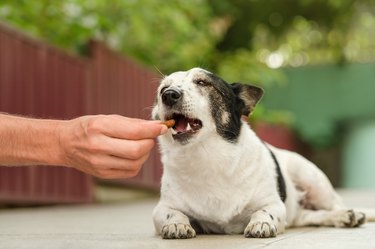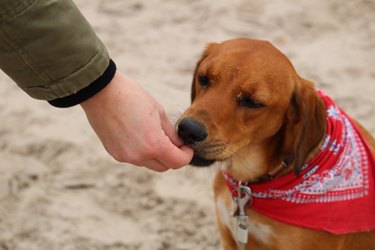No pet parent likes seeing their beloved companion experience fear, anxiety or stress. It can be especially difficult when the stimulus provoking those negative emotional responses is something you encounter on a regular basis. Luckily, there are proven interventions that can help your pet feel more comfortable!
With a thoughtful plan, and more often than not with the guidance of a qualified professional, it is possible to work through complex behaviors including anxious, reactive, or aggressive behaviors.
Video of the Day
Video of the Day

If you live with a behaviorally challenging pet, chances are you've been down the rabbit hole of behavior modification tactics. Two major concepts that you're likely run into are desensitization and counterconditioning (sometimes abbreviated DS/CC by behavior professionals). As simple as these terms might seem, the devil is in the details. To apply these strategies effectively, there are some critical nuances to keep in mind.

What is desensitization? What is it not?
Desensitization refers to the gradual, systematic exposure of an individual to a typically aversive stimulus (ie: trigger), with the end goal of reducing that individual's responsiveness to the stimulus. In true desensitization, the animal should not exhibit any fearful, anxious, or aggressive responses because we start with the mildest possible version of the trigger. One of the best ways to come up with a desensitization plan is to write out a list of triggers starting at the easiest level, and ending in the most difficult, that you work through at the animal's pace.
For example, if there was a dog scared of taking baths, the first step wouldn't be filling the bathtub with water, getting out all of the grooming supplies and leading the dog into the bathroom. It might simply be listening to the sound of water running from the next room over. Keep in mind that this can be a slow process spanning weeks, months, or years depending on the severity of the issue! In the long run, slow is fast.
The key to proper desensitization is the gradual nature of it, and increasing difficulty only when the animal is showing us relaxed body language at the prior stage. Rushing this process can not only slow your progress, but can actively cause harm and make the problem even worse. "Flooding" is a common practice, often justified with something along the lines of "letting the animal figure it out." Rather than systematically introducing a mild version of the trigger, flooding refers to exposing a learner to the full intensity and intentionally provoking an adverse response. Going back to our bath example, this might look like restraining the dog during a full bath until the dog gives up and stops responding. This approach often puts the animal in a state called learned helplessness, which greatly compromises welfare and can cause permanent harm.

What is counterconditioning? What is it not?
You have probably learned about classical conditioning, sometimes called Pavlovian conditioning, through the stories about Pavlov's dogs. In these experiments, dogs were presented with the sound of a metronome, which was immediately followed by food. With repetition, the dogs made the association that the sound=food, and researchers noticed an anticipatory response of salivation at the sound even when there was no food present.
Now imagine that instead of pairing that sound with food, it had been paired with something unpleasant, like a spray of cold water. Rather than seeing the positive anticipation of food, we would likely see fearful or aggressive responses associated with the unpleasant stimulus. In classical counterconditioning, our goal is to teach the animal that this sound no longer means something unpleasant (ie: spraying with water), it means something amazing (ie: food!)
On its face, counterconditioning is the process through which we pair the trigger with something the learner enjoys, with the end goal of changing the animal's emotional response to the trigger. Sticking with our example of the dog scared of baths, this might mean pairing bathtime with something the dog really loves, like a lick mat covered in peanut butter. Eventually, the dog's emotional response to the bath might improve thanks to the positive anticipation of delicious peanut butter.
It is important to note that counterconditioning is not intended to "distract" the learner from the trigger. In fact, we want them to notice the trigger before we present food, toys, or whatever pleasant thing we are using in our conditioning. The timing of events here is critical; if we present the food before the trigger appears, we may very well teach our learner that the food makes the scary thing appear, and food as a whole may be poisoned as a result.

How are desensitization and counterconditioning applied?
While desensitization and counterconditioning can both be applied independently, it's most likely your behavior consultant will recommend combining these strategies. This means that we are both gradually exposing the animal to versions of the trigger they can handle without a fearful or aggressive response, while also pairing the trigger with something the animal loves. This two-pronged approach helps us ensure that the learner is under-threshold and able to make new associations effectively.
Let's revisit our bath example one last time. If we were to use a combined desensitization and counterconditioning protocol, this might mean we start by running the water in the bath for a short duration while the dog enjoys peanut butter and listens to the sound in the other room. Once we see positive anticipation from the dog upon hearing the sound of the bath, we could try moving slightly closer or introducing a different aspect of the bath routine. With a well thought out plan, we can work our way towards a stress-free bath experience for everyone involved!
Finding a qualified professional
There is a fine line between simple and easy when it comes to behavior change. If you and your dog (or other pet) need help overcoming anxious, reactive, or aggressive behaviors, hiring a qualified professional is highly recommended! Look for individuals in your area who have the appropriate credentials, qualifications, and background.
Remember, meaningful behavior change takes time. Be patient with your pets and with yourself!